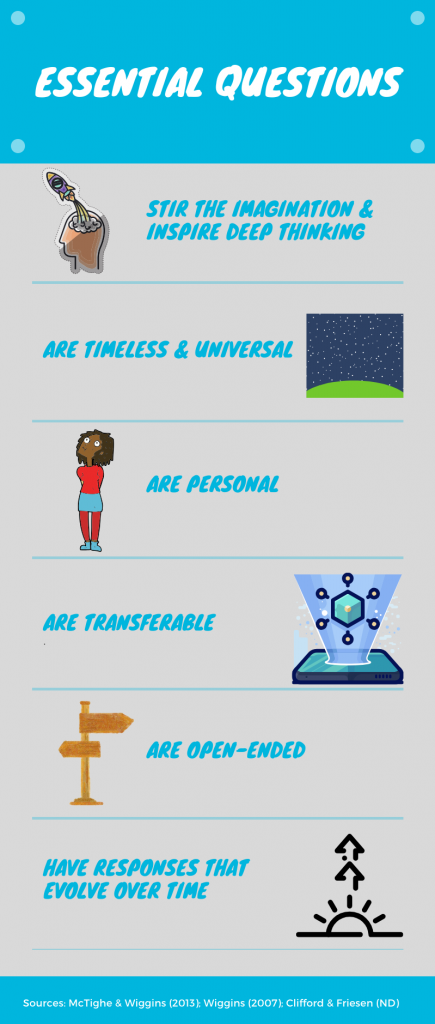
Essential questions provide context for individual understandings or skills. They connect the small to the large, the known to what still must be explored. If designed well and integrated into instruction, they help students think bigger, communicate better, analyze and synthesize what they learn and transfer that knowledge to other subject areas both inside and outside of school.
In this module of our class Educational Technology Leadership, I chose to focus on ISTE Coaching Standard 2f: “Coach teachers in and model incorporation of research-based best practices in instructional design when planning technology-enhanced learning experiences.” (ISTE, 2011). I wanted to better understand what essential questions are and how technology can support their use.
What are Essential Questions?
Essential questions are “broad in scope and timeless by nature.” They are used to introduce the big ideas in a discipline and help students make sense of “important but complicated ideas” (Wiggins 2007).

Examples of essential questions (McTigh & Wiggins, 2013, pp 5, 13) include:
- “What makes a story timeless?”
- “What ‘truths’ can we learn from fiction?”
- “Where is the balance between personal freedoms and common good?”
- “How does where you live influence how you live?”
The video below shows a helpful summary of essential questions and includes the ideas that EQs are inclusive, personal, and accessible, regardless of background or experience.
Overarching and Topical EQs
One aspect of essential questions that was unclear to me is how general vs. specific they should be. McTighe & Wiggins (2013) address this by distinguishing between overarching and topical essential questions. Topical essential questions fit under broader EQs and are the key to enabling students to transfer knowledge to other areas. An example given by the authors (p. 9) is:
| Overarching | Topical |
| “Whose story (perspective) is this?” | “How did Native Alaskans view settlement of their lands?” |
| “How are structure and function related?” | “How did the structure of various insects help them survive?” |
Both the topical essential questions above support the overarching EQs.
Nonessential Questions
According to McTighe & Wiggins (2013), essential questions do not guide, lead or hook. Though guiding questions can allow inference and can be asked multiple times, they are not truly open-ended; they help teachers “…achieve specific outcomes” (p. 11). An example of a guiding question is: “Why is it important to add comments to your code?”
Leading questions are rhetorical, pointing to a predetermined answer. They are useful for checking a student’s knowledge of facts (p. 11). An example of a leading question is “What is the capital of Venezuela?” Leading questions are asked once and do not encourage further thinking.
Hooks are used to initially get students interested in a topic, but are usually asked only once or twice (p. 14).
Coaching & Essential Questions
While addressing standards-based topics in day-to-day teaching, it can be easy to overlook essential questions. As coaches work with teachers to improve lessons by increasing engagement and designing problem-based tasks, formulating essential questions becomes part of that process (Foltos, 2013). As indicated above, what is or isn’t an essential question is not always clear, and it is useful for coaches and teachers to agree on what defines an essential question prior to working on a lesson together.
Extracting Essential Questions from Standards
McTighe and Wiggins (2013) suggest a helpful way to sift through standards to access essential questions by identifying the key verbs and reoccurring nouns that appear. I looked at two of the Washington State Computer Science Standards for grades 3-5 and tried to apply this:
| Standard | Essential Question |
| Standard 1B-CS-02 : Model how computer hardware and software work together as a system to accomplish tasks. | How can different parts of a system work together to accomplish something? |
| Standard 1B-DA-07 Use data to highlight or propose cause-and-effect relationships, predict outcomes, or communicate an idea. | How can we use collected information or observations to show relationships between things and predict what might happen in the future? |
Using Technology to Support Essential Questions
The key aspects of essential questions that lend themselves to technology include exploration, sensemaking, communication and expression. When tackling real-world, problem-based tasks linked to essential questions, students can use technology to:
- Conduct research via online books, articles, videos, images, or by videoconferencing with experts
- Curate and synthesize their research using tools like Wakelet, Padlet, OneNote, Mendeley or mind mapping software
- Record how their responses to the essential questions have evolved as their knowledge grows via online journals, blogs, or vlogs. These tools can also be used for formative and summative assessments (Peer Ed, 2018).
- Exchange ideas with others (texts, email, social media, video conferencing) as they explore essential questions
- Communicate their response to essential questions using tools and platforms they are familiar with and relate to (online apps, blogs, social media)
Making Meaning
Essential questions to me are what make learning and teaching worthwhile (and fun). If I can’t connect what I’m teaching to something bigger, then I don’t understand it well enough myself or I’m not thinking deeply enough. Essential questions should inspire teachers as much as students. Coaches can help teachers they work with see their curriculum with fresh eyes and reconnect with the big ideas of their lessons.
References
Clifford P. & Friesen, S. (N.D.). Creating essential questions. Galileo Educational Network. Retrieved from: https://galileo.org/resource/creating-essential-questions/
Curriculum Basics: Essential Questions (August 4, 2019). Atlas (Faria Education Group). Retrieved from: https://youtu.be/TSs5VcWMqTI”
ISTE Standards, Coaches (2011) Retrieved from: https://id.iste.org/docs/pdfs/20-14_ISTE_Standards-C_PDF.pdf
Foltos, L. (2013). Peer Coaching. Thousand Oaks, CA: Corwin.
McTighe, J., & Wiggins, G. (2013). Essential questions: Opening doors to student understanding. Alexandria, VA: ASCD.
Wiggins, G. (November 15, 2007) What is an essential question? Big Ideas. Retrieved from: https://www.authenticeducation.org/ae_bigideas/article.lasso?artid=53
I really like the universal and ageless part of essential questions – the example in the video helped me to understand this better. Actually, the whole video really helped me to understand the differences between types of questions and when to use what and why! The way you integrated technology ideas to support EQ’s is also really helpful and your idea of using a tool to watch student thinking evolve around an essential question is really powerful. I would love to do this with students! Great resources and this is such a helpful topic to learn more about, thank you!
Such a valuable topic, and great resources to help teachers understand the value of essential questions. Helping teachers understand what makes and essential question essential, valuable and worth including in learning activities is so critical to coaching. If we are asking how we can make learning more relevant to students’ lives outside of the classroom, essential questions can be one of the keys.
Bridget! You have brought Essential Questioning to life. The video and bookmark are great resources that I will put in my took kit to share with teachers. Thank you for showing how you could use tech tools to help teachers and students with EQ’s.
Bridget thank you for taking the time to explain essential questions and their impact on students learning. I appreciated your explanation on general vs. specific EQ’s and had the same question when I was doing my research. EQ’s are so powerful and knowing about how to craft and assess meaningful EQ’s can be so valuable as a coach! 🙂
Bridget- After reading your blog post, I felt so inspired to amp up my essential questions in my classroom! I like that you started the blog post with the focus of the benefits behind essential questions and included both real-world examples as well as a great visual info-graphic. The video you provided was super informative and gave me a better idea of what an essential question should encompass (being universal, open-ended, inclusive, and so on). I also appreciated your ability to take the importance of essential questions and find ways technology can be implemented through programs and/or devices to support this type of learning in the classroom. Thank you for sharing your research and resources!